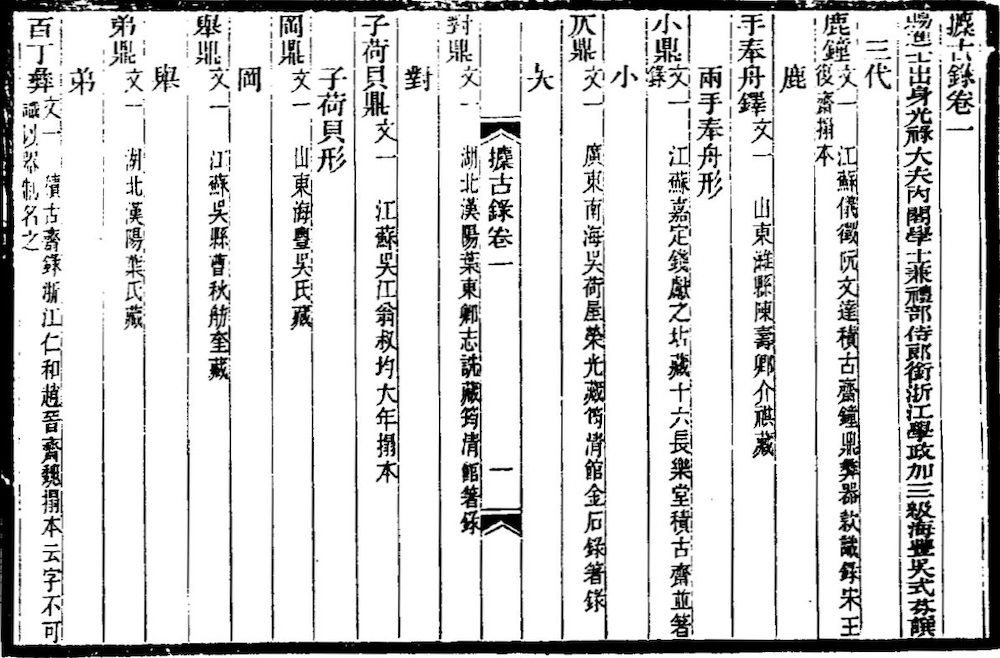Jungulu 攟古錄 (also written 捃古錄) is a catalogue of ancient inscriptions compiled during the late Qing period 清 (1644-1911) by Wu Shifen 吳式芬 (1796-1856), courtesy name Zibi 子苾, style Songsun 誦孫. He hailed from Haifeng 海豐, Shandong, and was Academician of the Grand Secretariat (neige xueshi 內閣學士) and Vice Minister of Rites (libu shilang 禮部侍郎).
Wu Shifen was an expert in phonological studies and commented on some of the Confucian Classics. Apart from that, he collected bronze and stone inscriptions, a field on which he wrote several books, like Jungulu jinwen 攟古錄金文 and Jungulu. The first had a length of 3 juan, the latter of 20 juan. All objects mentioned and described in the Jungulu jinwen are also included in the Jungulu (ch. 3).
The Jungulu records more than 18,000 inscribed objects from the Shang 商 (17th-11th cent. BCE) to the Yuan period 元 (1279-1368), which is the largest catalogue of collectables of the Qing period.
The Jungulu jinwen presents 1,334 inscriptions from the Shang and Zhou 周 (11th cent.-221 BCE) periods, records the inscriptions and transcribes them into modern script, and provides remarks on the history of the objects, in particular references to listings in other catalogues or researches of Xu Tongbai 徐桐柏 (1775-1854, author of the handbook Conggutang kuanzhixue 從古堂款識學), Zhu Shanqi 朱善旂 (1800-1855, author of Jingwuxinshi yiqi kuanzhi 敬吾心室彝器款識), or Chen Jieqi 陳介淇 (1813-1884, author of the catalogue Fuzhai jijin lu 簠齋吉金錄). The inscriptions are arranged according to time period, vessel types, and then according to the length of the inscription, beginning with one-character (or one-mark) inscriptions. In this way, the user can easily look up a particular inscription.
 |
Exemplary translation see below. |
The Jugulu includes a total of 1,781 bronze inscriptions, 15,230 stone inscriptions, 1,105 brick tiles, 6 pieces of wood, 4 jade pieces, and 2 porcelain pieces, making up a total of 18,128 objects with or without inscriptions. In the part of stone inscriptions, the writing style is of particular interest, and was described minutely.
When Wu Shifen died, the book was not yet finished. Seen from the information on the particular entries on objects and their collectors, it can be guessed that the book was compiled between 1852 and 1874. His son Wu Chongxi 吳重熹 (1838-1918) had the book proofread and printed. All renderings of inscriptions are based on the copies of Sun Wubin 孫吳豳, who had the right touch in exactly reproducing the shape of original characters and signs.
Sun Yirang 孫詒讓 (1848-1908), author of the book Guzhou yulun 古籀餘論, made some corrections to Wu Shifen's notes. Further corrections were carried out by Rong Geng 容庚 (1894-1983) and Dai Jiaxiang 戴家祥 (1906-1998).
A reprint of the book was published in 1895, another one in 1913. In the 1929 edition the text is spread over three volumes.
The scholarly value of Wu's catalogue is higher than earlier books on bronze inscriptions like Ruan Yuan's 阮元 (1764-1849) Jiguzhai zhongding yiqi kuanzhi 積古齋鐘鼎彝器款識 or Wu Ronguang's 吳榮光 (1773-1843) Junqingguan jinwen 筠清館金文.
| 三代 | [Inscriptions of objects from the] Three Dynasties |
|---|---|
| 鹿鐘 文一 江蘇儀徵阮文達「積古齋鐘鼎彝器款識錄」宋王「復齋」搨本 鹿 |
Lu 鹿 Bell 1 character Recorded in Jiguzhai zhongding yiqi kuanzhi by Ruan Wenda (i.e. Ruan Yuan 阮元) from Yizheng, Jiangsu, as a copy of a rubbing in the [Zhongding kuanzhi 鐘鼎款識] of Wang [Houzhi's] 王厚之 Fuzhai Studio of the Song period. [Inscription:] 鹿 |
| 手奉舟鐸 文一 山東濰縣陳壽卿介祺藏 兩手奉舟形 |
{Hand lifing a boat} Bell 1 character In the collection of Chen Shouqing ([courtesy name] Jieqi) of Weixian, Shandong [Inscription:] {[character consisting of] a hand lifing a boat} |
| 小鼎 文一 江蘇嘉定錢獻之坫藏「十六長樂堂」、「積古齋」並箸錄 小 |
Xiao 小 Tripod 1 character Recorded in the Shiliuchangletang [guqi kuanzhi kao] 十六長樂堂古器款識考 on the collection of Qian Xianzhi ([courtesy name] Dian) from Jiading, Jiangsu, and the Jiguzhai [zhongding yiqi kuanzhi] [Inscription:] 小 |
| 仄鼎 文一 廣東南海吳荷屋榮光藏「筠清館金石錄」箸錄 夨 |
Ze 仄 Tripod 1 character Recorded in the Yunqingguan jinshi lu by Wu Hewu ([courtesy name] Rongguang) from Nanhai, Guangdong [Inscription:] 夨 |